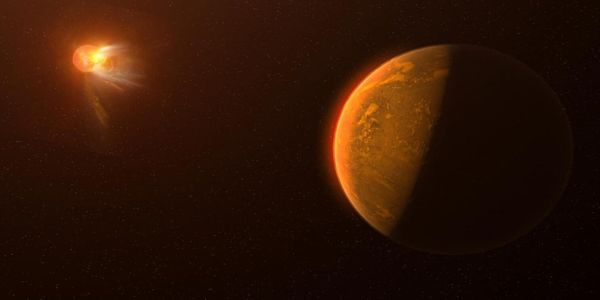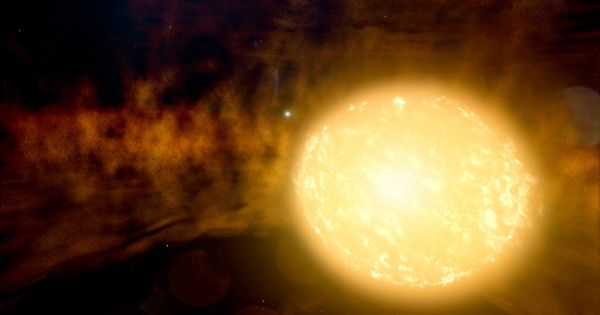The largest flare ever recorded from the sun’s nearest neighbor, the star Proxima Centauri, has been discovered by scientists. The study, published in The Astrophysical Journal Letters, was led by the University of Colorado Boulder and has the potential to shape the search for life beyond Earth’s solar system.
CU Meredith MacGregor, an astrophysicist at the University of Colorado Boulder, described Proxima Centauri as a small but powerful star. It is only four light-years or more than 20 trillion miles from our sun and is home to at least two planets, one of which may resemble Earth. It’s also a “red dwarf,” the name given to a type of star that is unusually small and dim.
The mass of Proxima Centauri is roughly one-eighth that of our own sun. But don’t be fooled by that.
MacGregor and her colleagues observed Proxima Centauri for 40 hours using nine telescopes on the ground and in space in their new study. They got a surprise along the way: Proxima Centauri ejected a flare, or a burst of radiation that begins near the surface of a star, that was one of the most violent seen anywhere in the galaxy.
Researchers observed a record-setting flare from the star Proxima Centauri – a burst of energy roughly 100 times more powerful than any similar event seen from Earth’s sun.
“Over the course of a few seconds, the star went from normal to 14,000 times brighter when seen in ultraviolet wavelengths,” said MacGregor, an assistant professor at CU Boulder’s Center for Astrophysics and Space Astronomy (CASA) and Department of Astrophysical and Planetary Sciences (APS).
The findings of the team point to new physics that could change how scientists think about stellar flares. They also don’t bode well for any squishy organism brave enough to live so close to the volatile star.
“If there was life on the nearest planet to Proxima Centauri, it would have to be very different from anything on Earth,” MacGregor said. “A human on this planet would have a difficult time.”
Active stars
The star has long been a target for scientists looking for life outside of our solar system. For starters, Proxima Centauri is nearby. It also has one planet, Proxima Centauri b, that is located in what scientists call the “habitable zone” – a region around a star that has the right temperature range for a planet’s surface to have liquid water.
But there’s a catch, according to MacGregor: Red dwarves, the most common stars in the galaxy, are also unusually active. “A lot of the exoplanets we’ve discovered so far are orbiting these types of stars,” she explained. “But there’s a catch: they’re far more active than our sun. They flare up a lot more frequently and with a lot more intensity.”
To determine how much Proxima Centauri flares, she and her colleagues pulled off something akin to an astrophysics coup: Over the course of several months in 2019, they pointed nine different instruments at the star for 40 hours. The Hubble Space Telescope, the Atacama Large Millimeter Array (ALMA), and NASA’s Transiting Exoplanet Survey Satellite were among those looking (TESS). Five of them captured the massive flare from Proxima Centauri, capturing it as it produced a broad spectrum of radiation.
“We’ve never had this kind of multi-wavelength coverage of a stellar flare before,” MacGregor said. “You’re usually lucky if you can get two instruments.”

Crispy planet
The method produced one of the most detailed anatomies of a flare from any star in the galaxy. The occurrence in question occurred on May 1, 2019, and lasted only 7 seconds. While it didn’t emit much visible light, it did emit a significant amount of ultraviolet and radio, or “millimeter,” radiation.
“We didn’t know stars could flare in the millimeter range before, so this is the first time we’ve gone looking for millimeter flares,” MacGregor explained. Those millimeter signals, according to MacGregor, could help researchers learn more about how stars generate flares. Currently, scientists suspect that these bursts of energy occur when magnetic fields near a star’s surface twist and snap with explosive consequences.
Overall, the observed flare was roughly 100 times more powerful than any similar flare seen from the sun on Earth. Such energy, over time, can deplete a planet’s atmosphere and even expose life forms to lethal radiation.
That type of flare may not be uncommon on Proxima Centauri. In addition to the big boom in May 2019, the researchers recorded a slew of other flares while watching the star for 40 hours. “The planets of Proxima Centauri are being hit by something like this not once in a century, but at least once a day, if not several times a day,” MacGregor explained.
The findings imply that the sun’s closest companion may have more surprises in store for us. “There will most likely be even more strange types of flares that demonstrate different types of physics that we haven’t thought of before,” MacGregor predicted.
Steven Cranmer, associate professor in APS and the Laboratory for Atmospheric and Space Physics (LASP) at CU Boulder; Adam Kowalski, assistant professor in APS and LASP at CU Boulder, also of the National Solar Observatory; Allison Youngblood, a research scientist at LASP; and Anna Estes, undergraduate research assistant in APS, are also coauthors on the new study.
Carnegie Institution for Science, Arizona State University, NASA Goddard Space Flight Center, University of Maryland, the University of North Carolina at Chapel Hill, University of Sydney, CSIRO Astronomy and Space Science, Space Telescope Science Institute, Johns Hopkins University, the Center for Astrophysics | Harvard & Smithsonian, and the University of British Columbia also contributed.
















